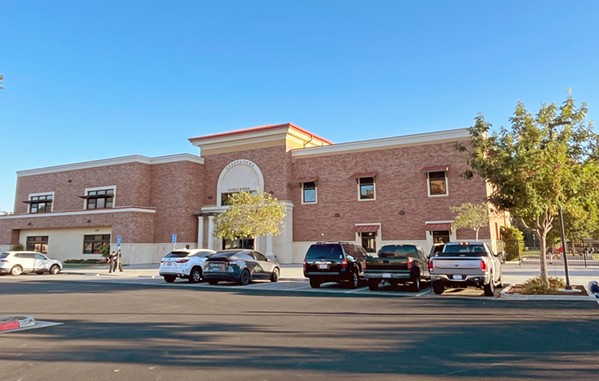[
{
"name": "Newsletter Promo",
"id": "NewsletterPromo",
"class": "inlineCenter",
"insertPoint": "4",
"component": "15264767",
"requiredCountToDisplay": "0"
},
{
"name": "Ad - Medium Rectangle CC01 - 300x250 - Inline Content",
"class": "inlineCenter",
"insertPoint": "8",
"component": "15582119",
"requiredCountToDisplay": "12"
},{
"name": "Ad - Medium Rectangle LC01 - 300x250 - Inline Content",
"class": "inlineCenter",
"insertPoint": "18",
"component": "15582122",
"requiredCountToDisplay": "22"
},{
"name": "Ad - Medium Rectangle 9 - 300x250 - Inline Content",
"class": "inlineCenter",
"insertPoint": "28",
"component": "15582121",
"requiredCountToDisplay": "32"
}]
Leaky roofs. Deteriorating classrooms. Insufficient and outdated technology.
These are a few reasons why two North County school districts are asking voters to approve multi-million-dollar bonds this November with the goal of improving school campuses and enhancing students' access to quality education.
Atascadero Unified School District Superintendent Tom Butler said the district is proud of the courses it offers to students, from vocational training to science, technology, engineering, art, and math (STEAM); however, its facilities do not reflect the quality of these courses.
"It's nice to have the facilities to support those curriculum experiences," Butler said. "And so when we're talking about the trades and we're talking about career pathways, we want to be utilizing the most current equipment, tools, and technology that are in those industry fields, as well as when we're talking about science and engineering and mathematics for those university-bound careers."
To do that, Atascadero Unified is placing Measure B on the ballot—a $110 million general obligation bond that promises to transform local schools. The measure aims to renovate vocational and career technical facilities, upgrade STEAM classrooms and labs, expand workshop classrooms, improve campus safety, and create greater accessibility.
If passed, property-tax paying voters would see an increase of $46 annually per $100,000 of assessed land value.
According to Butler, the district based Measure B's objectives off a survey it sent out to the community earlier this year, after finding that its students showed a great interest in the science and vocational fields.
"So certainly, we know there's interest there. And these are very highly engaging fields that lead into either post K-12 university-based education opportunities, or they can go straight into head-of-household jobs," he said. "Our community really values that, and fortunately for us, our students find these to be highly interesting and beneficial also."
This isn't Atascadero Unified's first ask for a bond. In 2010, voters passed $117 million Measure I-10 for school facility improvements and later voted to reauthorize that bond in 2014, increasing the annual property taxes to pay the bond off faster.
According to Atascadero Unified's assistant superintendent, Jackie Martin, that $117 million measure is expected to be paid off by 2042, and this year's Measure B would be an additional line item for taxpayers.
Atascadero school district board member Matt Pennon said that before becoming a board member, he hadn't understood the importance of bonds, and he encouraged voters to ask questions to understand how Measure B helps the entire community.
"I've always been passionate about education, and now every time I see a bond like this I try and do as much research as possible before voting on it," he said. "I really hope that most voters like myself want to do what's best for our schools because they are a cornerstone of our communities."
Not only would Measure B allow the district to provide updated technology and equipment for students—such as 3D printers—the funds would also be used toward campus safety.
"[Safety] is a big part of this bond—making sure that we can have a learning environment for students where they get to come to school, and what they're focused on is learning and engaging in their education in a way that works best for them, and being able to do that in a safe way," Pennon said.
Improving safety on campus could include installing badge-access doors and developing secure systems for allowing visitors.
"I'm a parent too, so I speak from my heart when it comes to this because these are my kids that are on these school site campuses. So I know every day that I drop them off that I want them to be safe," Pennon said.
Templeton Unified School District shares many of the same goals and concerns.
School district board Clerk Janel Armet said Templeton's $52.3 million general obligation bond—Measure D—aims to make its K-12 schools more secure and safe for students. The money would help renovate classrooms and update the district's STEAM facilities, costing Templeton landowners an extra $60 per $100,000 of assessed value.
"One thing that's important to me is installing security and keyless entry access and an emergency communication system," Armet said. "Technology has come [far] in the past few years. We're just not up to date, and so we'd really like to update those just to make sure we have a secure, safe, comfortable campus for our kids."
Armet said that Templeton schools' portable classrooms are out of date, and according to state standards they aren't usable anymore.
"Many of our portables are expired or outdated, and the state gives 25 years. We've had portables for 30-plus years. So when you get to that range, you can't just renovate or repair. You have to get a new portable in its place. And I think that's where the bigger cost comes in," Armet said.
These portables have leaky roofs, plumbing issues, and lack air conditioning, and Armet said these are not conditions they want their students to learn in.
Being a small district, Templeton simply doesn't have the money to keep up with improving technology and modern amenities, despite a previous $35 million bond passed in 2012, Armet said.
According to Ian Trejo, Templeton assistant superintendent, the district used the previous bond to update technology, replace portable classrooms, and expand vocational facilities.
At the board's Sept. 12 meeting, Trejo said that the $26 million "touched every corner of the district," with more than half the funds for Templeton High School, $8 million for the elementary, and $2.6 million for the middle school.
Despite these investments and upgrades, board member Nelson Yamagata said at the meeting that buildings still get old and need repairs, hence Measure D.
Measure D will also be a new line item for taxpayers, and the previous bond is expected to be paid off by 2046, according to Trejo.
Armet said that in addition to security and replacing portable classrooms, the district also wants to grow its transitional kindergarten program and add STEAM facilities for students as young as middle school.
"I hope that [voters] see the importance of our kids in our community and how important it is for them to get the best education that they can in a comfortable and safe environment, and that all this money does stay local," she said. "I understand that it is an ask of our community to take on the obligation of this bond—and we don't take that lightly. We don't take that lightly at all."
If the measures pass—they need 55 percent of the votes—both the Atascadero and Templeton districts would form independent citizens oversight committees to provide transparent reporting on how the multi-million-dollar bonds are being used.
"As a property owner and as a parent, I would just want to know where the money was going, and so that's why I am committed to being transparent about where we would be using the money for the school district," Armet said.
"There's definitely checks and balances to the uses of bond money going forward, so we're committed to that to ensure that the proper use is being done." Δ
Reach Staff Writer Libbey Hanson at [email protected].






